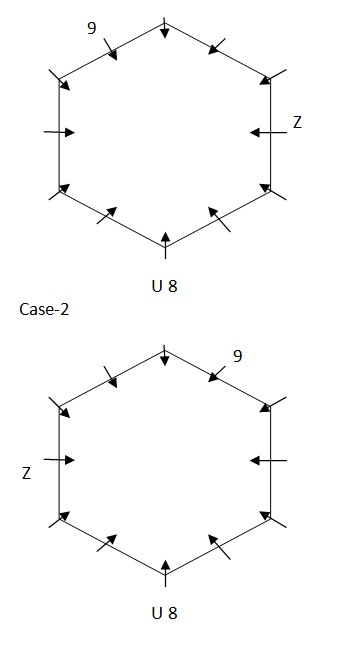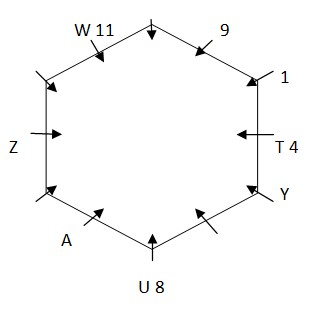Question
What is the sum of room number of V, A, Q, X and
Z? Study the following information carefully and answer the questions given below it. Twelve persons P, Q, R, S, T, U, V, W, X, Y, Z and A are sitting around a hexagonal shaped table facing center. Six persons are sitting at corners of the table and remaining persons are sitting at the edges of the table. They all are living in different rooms numbered 1 - 12.Consecutive alphabetical names of the persons are not adjacent to each other. Consecutive numerical room numbers of the persons are not adjacent to each other. Two persons are sitting between Z and U who lives in room number 8.U sits at one of the corner of the table. Three persons are sitting between Z and the one who lives in room number which is square of an odd number but not 1. T sits fourth to the right of A who sits adjacent to U. T lives in room number 4.Immediate neighbor of U lives in the prime numbered room. Four persons are sitting between W and Y when counted from left of W who is not an immediate neighbor of Z. The one who lives in room number 1 sits third to the left of W who lives in room number 11. R and V are immediate neighbors. Q sits second to the right of the one who lives in room number 3.The one who lives in room number 12 sits second to the left of X. Q and S lives adjacent to each other. P lives in room number 10. Q and W are not an immediate neighbor of each other. The room number of R is greater than the room number of Z.Solution
Two persons are sitting between Z and U who lives in room number 8. U sits at one of the corner of the table. Case-1  Case-2
Case-2  Three persons are sitting between Z and the one who lives in room number which is square of an odd number(9) but not 1. Case-1
Three persons are sitting between Z and the one who lives in room number which is square of an odd number(9) but not 1. Case-1  T sits fourth to the right of A who sits adjacent to U. T lives in room number 4. Case-1
T sits fourth to the right of A who sits adjacent to U. T lives in room number 4. Case-1  Immediate neighbors of U lives in the prime numbered room. Four persons are sitting between W and Y when counted from left of W who is not an immediate neighbor of Z. The one who lives in room number 1 sits third to the left of W who lives in room number 11. Case-1
Immediate neighbors of U lives in the prime numbered room. Four persons are sitting between W and Y when counted from left of W who is not an immediate neighbor of Z. The one who lives in room number 1 sits third to the left of W who lives in room number 11. Case-1  Case-2
Case-2  R and V are immediate neighbors. Q sits second to the right of the one who lives in room number 3. Q and W are not an immediate neighbor of each other. Q and S lives adjacent to each other. The one who lives in room number 12 sits second to the left of X. P lives in room number 10. The room number of R is greater than the room number of Z. Case-1
R and V are immediate neighbors. Q sits second to the right of the one who lives in room number 3. Q and W are not an immediate neighbor of each other. Q and S lives adjacent to each other. The one who lives in room number 12 sits second to the left of X. P lives in room number 10. The room number of R is greater than the room number of Z. Case-1  Case-2 final
Case-2 final 
- M and N started a business. M invested Rs. 1600 and N invested Rs. ‘t’. N withdrew after 6 months. If M received Rs. 5000 out of the total annual profi...
P and Q started a business by investing Rs.8000 and Rs.6400 respectively. After 7 months, Q increased his investment by a certain percentage such that a...
A and B started a business by investing Rs.8000 and Rs.11000 respectively. After 6 months A withdrew 50% of his investment. If at the end of the year, p...
A and B started a business by investing Rs. 12,000 and Rs. 18,000 respectively. A also worked as the active manager and for that he is entitled to recei...
'A' and 'B' started a business by investing Rs. '7x' and Rs. '5x' respectively. Nine months later, 'A' withdrew Rs. 600 from his investment whereas 'B' ...
‘A’ and ‘B’ started a business by investing certain sum in the ratio 2:3, respectively for 6 years. If 30% of the total profit i...
Brahma, Vishnu and Mahesh invested money in the ratio of 1/2:1/3:1/4 in a business. After 4 months, Brahma doubled his investment and after 6 months, Vi...
Raj and Anjan initiated a business with investments in the ratio of 4:5, respectively. After 4 months, Kumari joined the venture with an investment that...
‘A’, ‘B’ and ‘C’ started a business by investing Rs. 3000, Rs. 5000 and Rs. 2000, respectively. After 4 months, ‘B’ left and ‘A’ and...
A and B enter into partnership. A invests some money at beginning, B invests thrice the amount after 5 months and C invests double the amount after 9 mo...


